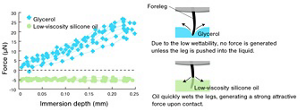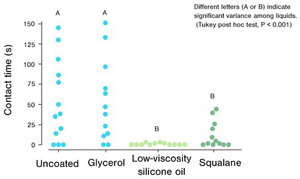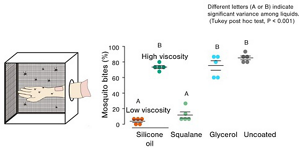Technology for Preventing Mosquito Bites Developed by Creating a Skin Surface Mosquitoes Dislike
—Protecting Against Mosquito-borne Infectious Disease—
The Personal Health Care Products Research Laboratory and Material Science Research Laboratory of Kao Corporation (President: Michitaka Sawada) have revealed that application of a low-viscosity silicone oil on human skin can prevent mosquitoes from staying on the skin, and can keep them from starting to blood-feed. Unlike conventional insect repellents, this mosquito repellent technology focuses on the microscopic structure of mosquitoes' legs, a new approach that alters the skin's surface to give it properties disliked by mosquitoes and preventing them from staying on the skin.
As vectors for infectious disease, mosquitoes have killed more people than any other creature on earth. Meanwhile, Kao's medium-term management strategy calls for becoming a company that protects future lives, and as part of that strategy, Kao hopes to apply this technology to helping protect people from mosquito-borne infectious disease.
These research results were published in Scientific Reports*1, an electronic journal of Nature Research.
-
* 1 Iikura, H., Takizawa, H., Ozawa, S., Nakagawa, T., Matsui, Y., Nambu, H. Mosquito repellence induced by tarsal contact with hydrophobic liquids. Sci. Rep. 10, 14480 (2020).
https://doi.org/10.1038/s41598-020-71406-y
Background
In recent years, the incidence of mosquito-borne infectious disease has increased dramatically, driven by global warming and the development of transportation networks, which have expanded the mosquito's habitat. According to a paper published in Nature in 2013, an estimated 390 million people per year are infected with Dengue fever after being bitten by the Aedes mosquito, which carries the pathogen*2. The WHO also notes that 40% of the world's population lives in areas at risk of Dengue fever.
-
* 2 Bhatt S., Gathing PW., Brady JO., Messina JP., Farlow AW., et al. The global distribution and burden of dengue. Nature. 496, 504-507, (2013)
Currently no effective vaccine or treatment for Dengue fever has been established, and symptomatic therapy is the only care available. This is why preventing mosquito bites is an important way of also preventing infection. In infected areas, regular application of insect repellent, along with clothes that reduce skin exposure are recommended, but Kao research has revealed that in fact in Indonesia, Thailand and Vietnam, where mosquito-borne infections occur year-round, 80% of the population is bitten by mosquitoes on an almost daily basis*3.
-
* 3 Survey conducted in 2020 (1,000 people in each country, age 18–59 years)
Development of a technology for repelling mosquitoes via tarsal contact with a wetting phenomenon
When landing on the skin, mosquitoes use their forelegs to stabilize their posture before beginning their blood-feeding behavior. Therefore, if the mosquito withdraws within a few seconds of landing on the skin, no blood-feeding occurs.
Kao thus began studying surfaces that mosquitoes dislike, using a high-speed camera to observe mosquitoes landing on a variety of surfaces. The results showed that mosquitoes will not stay on surfaces to which a particular hydrophobic oil had been applied, and will quickly fly away. Researchers also observed that afterward, the mosquitoes would rub their legs together in an action intended to wipe off the oil adhering to them.
Focusing on this phenomenon, Kao considered in detail what happens when the mosquito's legs come into contact with a liquid. When that liquid was water or glycerol, it remained in droplet form and it did not spread to the mosquito's legs. This is due to the unique microstructure of the legs, which are highly water-repellent. On the other hand, researchers also learned that squalane—also used in formulating skincare products—and low-viscosity silicone oil form droplets that spread to the legs within a short time after contact (Figure. 1).

Figure 1. Droplets of glycerol and low-viscosity silicone oil deposited on a surface that simulates a mosquito leg
When this wetting phenomenon occurs, in a short time a force is exerted on the mosquito's legs, drawing it into the liquid. Kao's researchers used a force tensiometer to measure the force generated when the mosquito's legs were brought into contact with the liquid. Results showed that when wetting from a low-viscosity silicone oil spread on the legs, it generated a capillary force*4 of approximately 5μN (Figure 2). This level of force represents a threat to small, light-weight insects such as mosquitoes, and is thought to trigger escape behavior.
-
* 4 The force generated by the wetting behavior of a liquid

Figure 2. Force value with respect to the immersed depth of the forelegs
Kao conducted further experiments involving getting mosquitoes to land on glass substrates to which liquids of varying wettability with respect to mosquito legs had been applied. Measuring the time the mosquito's legs were in contact with the glass substrate and the mosquito's subsequent flight revealed that the mosquitoes would not remain longer than three seconds on a substrate to which low-viscosity silicone oil had been applied (Figure 3).

Figure 3. Contact time of mosquito legs on liquid coated glass substrates
In tests on human skin, an average of 85% of female mosquitoes that landed on non-coated skin displayed blood-feeding behavior, while an average of only 4% displayed such behavior on skin to which low-viscosity silicone oil had been applied (Figure 4).

Figure 4. Mosquito bites on liquid-coated forearms
Discovery that hippopotamus secretions are also effective in preventing mosquitoes from staying
Kao believed there might be examples in the natural world of insect repellents utilizing this wetting phenomenon. Several animals are known to secrete sweat and other substances. The researchers speculated that the "red sweat" secreted on the skin of hippopotamus, in addition to providing UV protection and moisturizing, might also work to protect the animal from mosquitoes.
Hippopotamus secretions were provided by Adventure World in Wakayama Prefecture, and a silicone oil with properties similar to those secretions was prepared. We then conducted an experiment that involved getting mosquitoes to land on substrates to which each of the substances had been applied. The results revealed that both liquids were effective in reducing mosquito landings (Figure 5).
This result suggests that hippopotamus secretions have the ability to protect the skin from mosquitoes.

Figure 5. Contact time of mosquitoes on hippo-secretion-coated and water-coated substrates
Summary
Utilizing the wetting phenomenon, Kao has developed a method for protecting against mosquito bites. This is a new technology with a mechanism of action that differs from conventional insect repellents such as DEET and Picaridin, which rely on volatile active agents. Going forward, Kao plans to use the knowledge obtained from this study in the development of products to protect the skin from mosquitoes, and to contribute to protecting people from mosquito-borne infectious diseases.
About Kao
Kao creates high-value-added products that enrich the lives of consumers around the world. Through its portfolio of over 20 leading brands such as Attack, Bioré, Goldwell, Jergens, John Frieda, Kanebo, Laurier, Merries and Molton Brown, Kao is part of the everyday lives of people in Asia, Oceania, North America and Europe. Combined with its chemical division, which contributes to a wide range of industries, Kao generates about 1,500 billion yen in annual sales. Kao employs about 33,000 people worldwide and has 130 years of history in innovation. Please visit the Kao Group website for updated information.
Media inquiries should be directed to:
Corporate Communications
Kao Corporation
